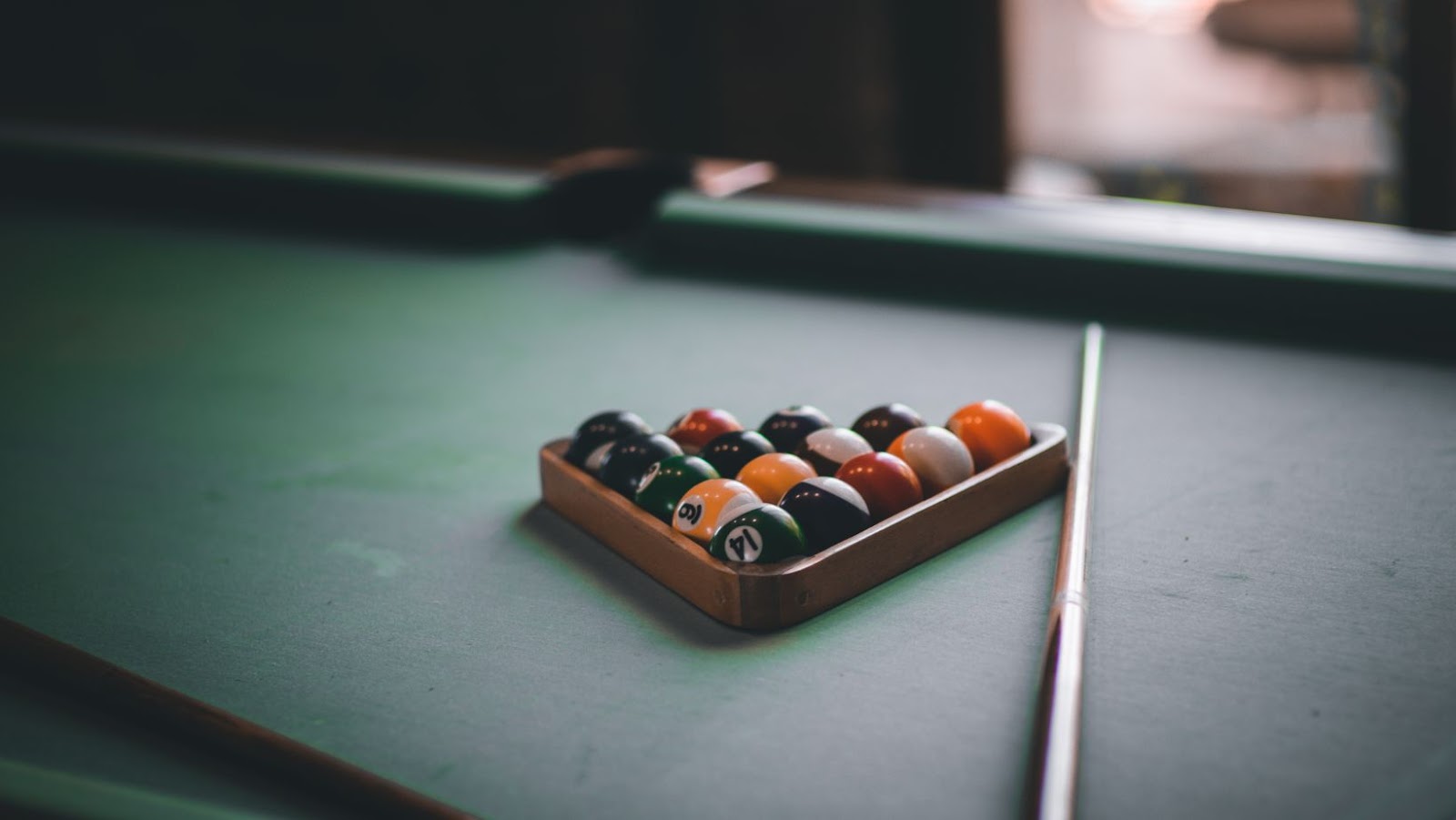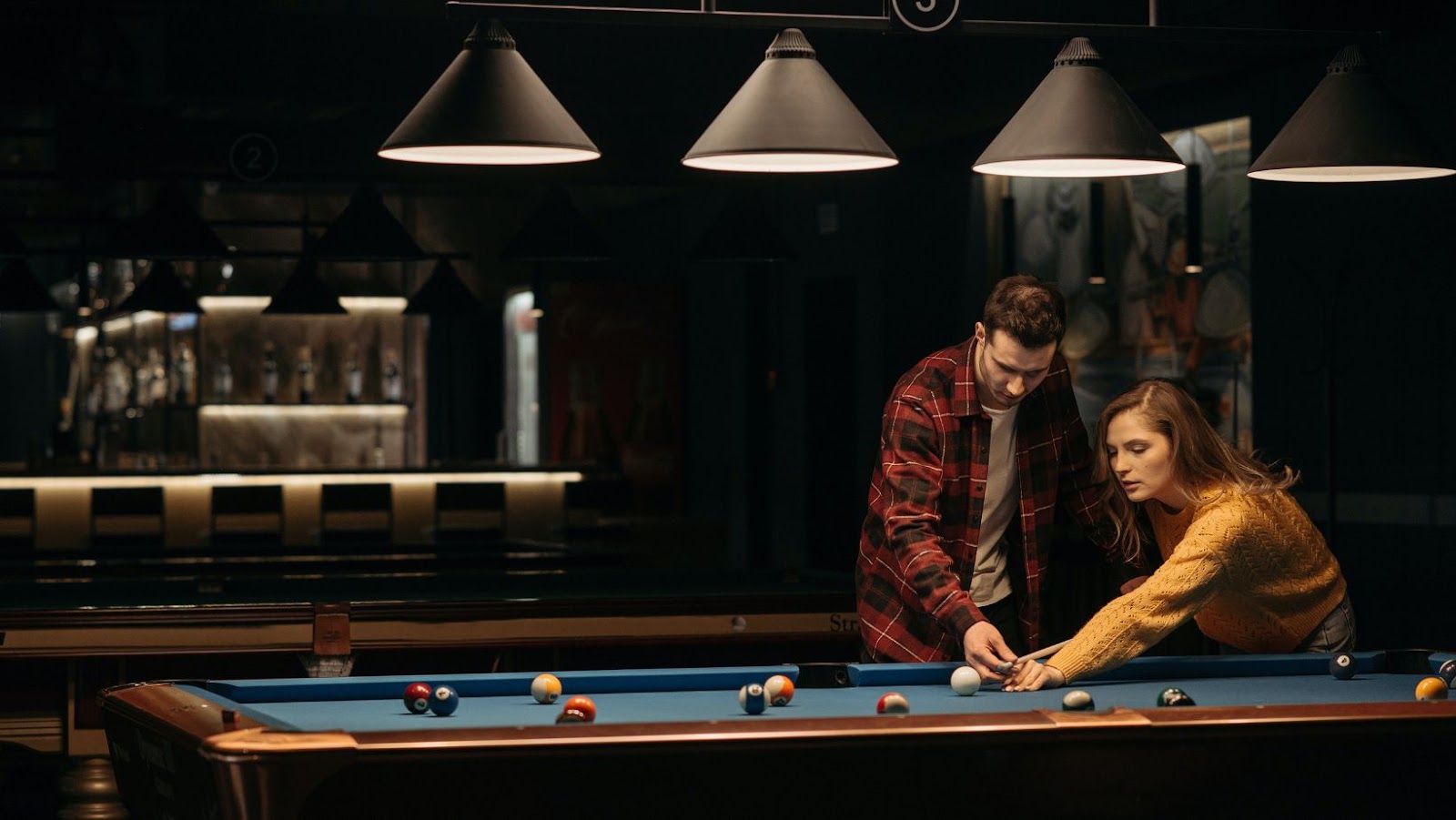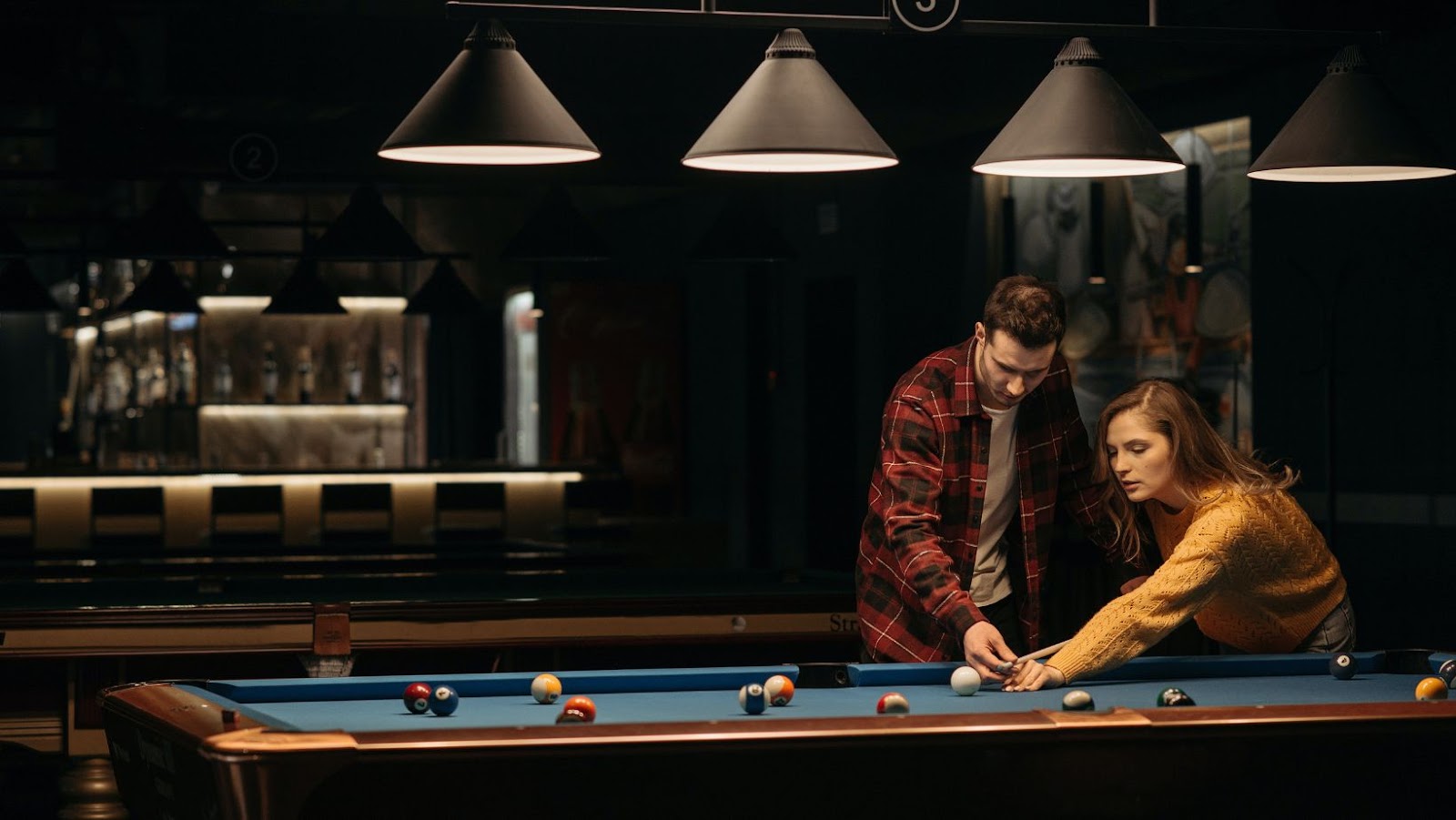Are you stuck between choosing between billiards and snooker? Let’s compare the two games to find out which one is best suited for you!
With the slight differences in the rules and table sizes, we’ll help you make an informed decision on whether to take up billiards or snooker. You’ll never have to ponder over which game to choose again!
Introduction to Billiards And Snooker
Billiards and snooker are cue sports that have been played around the world for centuries. The two games have many similarities, but there are also some key differences between them.
In both billiards and snooker, a cue stick is used to strike a white “ball” (either a phenolic resin ball in billiards or a rubber-bonded ivory ball in snooker) into balls of various colors, each with its own point value. Billiard balls typically come in six colors: red, orange, yellow, green blue and purple. Snooker balls come in 15 different colors: yellow (2 points), green (3 points), brown (4 points), blue (5 points), pink (6 points) , black (7 points) , yellow-green (8 Points ) white (9 Points). The main difference between the two games is that billiards is usually played on a felt-covered table with no pockets and has no designated areas for playing on the table. In contrast, snooker is usually played on a bed of short cloth nap covering rubber cushions around six pockets into which players must aim to score points by “potting” their colored balls.
Another key difference between the two games is the size of the tables: billiard tables typically measure 9’ x 4 ½’ feet while snooker tables measure 10′ – 12′ feet long. The size of the longer table results in bigger gaps between cushion at each end, allowing players to extend shots more than 60 inches away from their starting point when shots require cushion clearance before potting another ball However this luxury only comes into play when playing certain strategic shots that can be found only in Snooker such as intentional fouls and swerves and four cushion clearshots among others.
History of Billiards And Snooker
Billiards and snooker have a long and interesting history dating back to the 16th century when an early form of the game was created in Northern Europe. Billiards is believed to have originated in France in the 15th century, while snooker is thought to have been created by British army officers stationed in India during the 19th century. The two games have different origins and different structures, but they are both based around potting coloured balls into pockets on a rectangular table with cues. The main difference between billiards and snooker is that billiards is played with three balls (or more), while snooker uses 22 balls including one cue ball. In addition, snooker has much stricter rules and higher levels of complexity due to its larger number of balls which means it requires more skill than basic billiards.
In both games, players must pocket a certain number of coloured balls out of the set within a specified frame of time or certain number of strikes. As games progress different rules come into play such as potting two shots consecutively or shooting off cushions for additional points.

Although there are other differences between these two classic billiard activities, some similarities remain between them including the fact that both require strategic thinking, precision aiming skills, patience and steady nerves in order to be successful at either game.
Rules And Regulations
Billiards and snooker are two popular cue sports with overlapping histories and an overlapping pool of rules. While based on the same game, these two sports involve different rule sets and guidelines.
The Rules of Billiards: Billiards typically refers to a type of pocket billiard game played on a table without pockets. These tables have various markings that divide the playing surface into sections; depending on the game being played, players will use cues to strike balls and score points by hitting one or more balls into certain parts of the table in order to win. The rules for this variation of billiards can vary according to the specific type being played; however, generally, players must follow basic etiquette when it comes to shots and gameplay. Depending on the variation, players may need to differentiate between “legal” and “illegal” shots or they may be required to ensure that certain areas are cleared before taking their shot. Additionally, players may have certain restrictions or expectations concerning how far away from their cue ball they should stand whilst taking their shot. Rules of Snooker: Snooker is another popular form of pocket billiard game popularly associated with billiards that is more structured than other variants. Snooker tables also lack pockets for players to pocket balls in order for them score points; instead, there are six differently-sized pockets located around each corner of the table (denoted by colored discs) which players can use to attempt scoring points according to official snooker rules.. Depending on what type of snooker variant is being played (informal green-ball snooker or proper full-size snooker), a player must first correctly pot “hard” reds before attempting any colored balls that require correct “potting” and after potting a red ball they will switch turns if either strikes any part(s) of an additional ball other than their designated target ball (the red). The complexity involved with proper object-balling techniques apply as well as an extra dimension added when calculating cue power levels depending upon where relative distance between eachred/colored/black target ball(s) during play before ever striking an intended targetball.
Equipment And Accessories
Playing billiards and snooker requires specific equipment and accessories in order to have an optimal playing experience. Billiards and snooker are well-loved classic cue sports that involve pockets and balls, with each game having its own variety of rules.
Billiards is a game often played on a flat table without any pockets, while snooker is generally played on a bigger, pocketed table with more balls than billiards. Accessories for these two games differ slightly, depending on which game you choose to play.
For billiards, the first accessory needed would be the billiard cue stick – usually made of hard woods like maple or ash – along with the appropriate cue tips (made of leather). A set of billiard balls must also be used; these will vary in size from 2.5 inches to 3 inches per ball as well as in weight from 5 ounces to 7 ounces per ball respectively . For added convenience during your game, a triangle rack for pool balls is recommended so that all players can start their turns with ease when racking up their balls.
For snooker accessories, players may need a smaller cue than when playing billiards due to the smaller tables used for this game along with special numbers between 1 through 15 that indicate where each one should go so they can properly rack up the provided full set of 22 snooker balls; these indicators are found on the surface of professional Snooker tables or can be purchased separately too. Similarly required are specialized diamond-shaped rubber blocks with markings called “spots” which replace fingerholes typically seen in normal cues for starting off play for either player; additionally there should be 6 triangle blocks available at hand too for easy racking at any time during gameplay as necessary throughout your games’ progress.
Popularity of Billiards And Snooker
Billiards and snooker have long been popular around the world, but their popularity can vary significantly in different countries and regions. Billiards is the more widely known of the two games and is particularly popular in North America and Europe, where it has become a staple of many recreational activities. In contrast, snooker has become much more popular in the UK thanks to its televised professional tournaments (e.g. World Snooker Championship) which draw millions of viewers every year.

In terms of global popularity, overall both billiards and snooker are quite popular; however, there are some differences between the two games worth noting. For example, billiards does not require expensive equipment like a full-sized table or specialized cues like snooker does; thus, it is easier for people to start playing without having to invest too heavily in equipment or lessons. Furthermore, billiards can be easily adapted to almost any area while snooker requires specific table size requirements that need more space than a typical room or space can provide.
Similarly, billiards lend itself well to pool leagues and team play while snooker competitions occur mostly at the individual level – making it more challenging for beginners to find others with similar levels of skill as them. In addition, individual tournaments for both games exist at local and international levels allowing players an opportunity to showcase their skills on a professional platform if they want too!
Billiards vs Snooker
The sport of billiards and snooker primarily involve using a cue stick to shoot carefully aimed shots at an arrangement of colorful balls. Though both sports may seem quite similar, there are several key differences between the two that make them distinct from one another.
Billiards is a game characterized by a smaller table size and fewer balls than snooker and restricts the use of just three types of cue balls: white, yellow, and red. In Billiards, the aim is to pot either all the white balls or both colors of ball in a single break shot. Furthermore, games can be played with just two players or teams competing against each other until one is either declared victorious or a rivalry draw is declared due to running out of time or points. In comparison, Snooker uses yellow, green, brown grey and pink colored balls in addition to the traditional white and red ones used in billiards. The game also involves more complex rules that involve intending for one particular colour to go into its respective pocket based on score calculations; these score calculations refer to ‘fouls’ whereby if no colour ball goes into its intended pocket then as deduction from ones overall score occurs as consequence for missing their intended shot; thus spending more time when calculating each shot’s merit or consequence before implementing same usually becomes necessary while playing snooker thereby making it last longer than typical billiard matches. Additionally, as scenarios that require multiple players/teams occur often when playing snooker a match could potentially stretch on for hours before all requirements are met; whereas during billiard matches such scenarios almost never occur since competitively speaking two person team up’s tend not to exist during competitive play.
Strategies For Playing Billiards And Snooker
Billiards and snooker are both games played on tables that involve the use of varying types of cue sticks to pocketed balls. Although the basic rules and aims behind each game are similar, there are distinct strategies for playing each one.
For billiards, the player should focus on shots that enable them to remain in control of the table and have an optimal position for their next shot. This means avoiding long shots without a clear line of sight or angled shots that risk leaving the opponent with easy access to make their next shot. Taking careful aim before each shot also helps to ensure accuracy as well as reduce wasted time spent setting up a cascading series of combinations. Snooker focuses more on strategy rather than skill in many cases because it requires planning ahead for several ensuing moves in order to coax opponents into shooting slightly off their desired target locations. Before shooting, players must assess their position and consider all possible consequences from various shot combinations; this involves predicting where potential opponents’ balls will end up but also deciding which ones should be used in order to score. In addition to leaving less-desirable options open while having more control over how all players end up, snooker players can often trap opponents with clever shot placements or split them off into separate sections where they become isolated from scoring opportunities.
In conclusion, both billiards and snooker are great games to play that can provide hours of entertainment for friends and family. Ultimately, the game you choose will depend on personal preferences including what cues you prefer, the setup of the table, the size of the balls used, and even just which one sounds more appealing to you.
Whichever game you choose, it’s important to remember that both provide opportunities for strategy-making and skill development so don’t forget to have fun!
